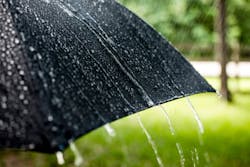Study: Homeowners could use rainwater to flush toilets
PHILADELPHIA — March 7, 2016 — New research published in the journal Resources, Conservation and Recycling suggests that, with large enough storage tanks, the average rainfall in four major U.S. cities would be enough to offset household water requirements for flushing toilets.
A team of environmental engineers at Drexel University found that it rains enough in Philadelphia, New York, Seattle and Chicago that, if homeowners had a way to collect and store the rain falling on their roofs, they could flush their toilets often without having to use a drop of municipal water.
A three-person family in a home with an average sized roof would need little more than a standard 1,000-gallon home storage tank to provide enough rainwater to cover over 80 percent of toilet flushes throughout the year.
This would potentially have a dramatic impact on household water use, because toilet flushing accounts for nearly one-third of potable water use in the United States and the United Kingdom. As the researchers pointed out, there is no reason that clean, treated water needs to be used to flush a toilet — rainwater could do the job just as well.
“People have been catching and using rain water for ages, but it’s only been in the last 20 to 30 years that we have realized that this is something that could be done systematically in certain urban areas to ease all different kinds of stresses on watersheds; potable water treatment and distribution systems; and urban drainage infrastructure,” said Franco Montalto, P.E., PhD, an associate professor in Drexel’s College of Engineering and director of its Sustainable Water Resource Engineering Lab, who led the research.
Rainwater harvesting has already been implemented in California in response to the ongoing drought, but this study is one of the first to examine in detail the feasibility and benefits of using it to offset potable water use for non-potable purposes while at the same time reducing urban stormwater runoff.
“When the natural landscape is replaced by a building, rain can no longer infiltrate into the ground,” Montalto explained. “It runs off, is captured in drains, where it can cause downstream flooding, carry pollutants that settle out of the air into local water bodies or — in the case of a city like Philadelphia or New York — cause the sewer to overflow, which leads to a discharge of untreated wastewater into local streams and rivers.
“So capturing rainwater can help to reduce the demands on the water treatment system and ensure that it will still function properly even during heavy rainfall events.”
